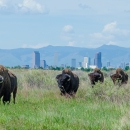About Us
This 5,237 acre site provides a refuge for both wildlife and visitors. Since 2007, The U.S. Fish and Wildlife Service has been managing the site to restore and preserve the native prairie ecosystems, provide habitat for migratory and resident wildlife, conserve and protect habitat for Preble’s meadow jumping mouse, and provide research and education opportunities.
The Refuge continues to see a steady increase in visitation as more urban people seek opportunities to connect with nature. While visiting, disconnect from the busy urban world, relax in nature, and get some exercise too! The Refuge is here for wildlife, our communities, and visitors from all over the world. And best of all, it's free to visit!
Our Mission
Each unit of the National Wildlife Refuge System is established to serve a statutory purpose that targets the conservation of native species dependent on its lands and waters. All activities on those acres are reviewed for compatibility with this statutory purpose.
At Rocky Flats National Wildlife Refuge, the purpose of this Refuge is to restore and preserve native ecosystems, which will in turn provide habitat for migratory and resident wildlife. Specific habitat management practices for the federally threatened Preble’s meadow jumping mouse will not only benefit this species but other species depend on riparian riparian
Definition of riparian habitat or riparian areas.
Learn more about riparian and wetland habitat for survival. In the future, the Refuge will provide environmental education, nature programs, and wildlife-focused visitor opportunities.
Our History
Prior to becoming a national wildlife refuge national wildlife refuge
A national wildlife refuge is typically a contiguous area of land and water managed by the U.S. Fish and Wildlife Service for the conservation and, where appropriate, restoration of fish, wildlife and plant resources and their habitats for the benefit of present and future generations of Americans.
Learn more about national wildlife refuge , Native Americans occupied the land intermittently prior to the 1800s. In 1868, the Scott family established a homestead here and raised cattle. Later, the Lindsay family raised cattle and built a house and barn in the 1940s.
In 1951, the U.S. Atomic Energy Commission acquired 2,519 acres, which included the Lindsay property, for the Rocky Flats Plant to produce nuclear and nonnuclear weapons including plutonium triggers for nuclear weapons. An additional 4,027 acres were acquired in 1974 for plant expansion.
The plant operated from 1952 to 1994 with manufacturing activities taking place in the center portion of the site with a large buffer zone around the area. The facility’s mission changed in 1989 to cleanup and closure. It was renamed the Rocky Flats Environmental Technology Site. Through the Rocky Flats Act of 2001, the site was established as a national wildlife refuge while cleanup was underway. The cleanup was completed in 2005.
The Refuge officially opened to visitors on September 15, 2018, with 10 miles of year-round trails for hiking, wildlife viewing, photography, hiking, bicycling, cross country skiing, snowshoeing, and horseback riding.




